

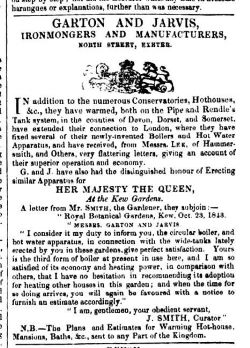 To promote and market the Company’s goods and services in the period up to the late 19th century Garton & Jarvis, and subsequently Garton & King, needed to rely on recommendation, on customers coming to your works or retail outlet, or by describing and tempting custom through the printed word such as in The Exeter Weekly Times (1827) or The Western Times (1829), Exeter Flying Post or Trewmans Weekly News. A rather unappealing example of this sort of format is seen here, dated 21st November 1843.
To promote and market the Company’s goods and services in the period up to the late 19th century Garton & Jarvis, and subsequently Garton & King, needed to rely on recommendation, on customers coming to your works or retail outlet, or by describing and tempting custom through the printed word such as in The Exeter Weekly Times (1827) or The Western Times (1829), Exeter Flying Post or Trewmans Weekly News. A rather unappealing example of this sort of format is seen here, dated 21st November 1843.
Up until the 1890s newspapers relied on text in the main to promote products and services and even in the 1840’s when photography came into use newspapers still had to rely on the printing processes of the time (i.e. wood / brass engraving) which could only accommodate black and white and no in-between shades of grey. The shades of grey found in a photograph could not be reproduced until half-tone images began to appear from 1890 onwards.
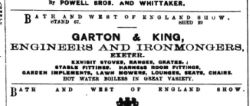 One other method became available in 1852 with the first Bath & West Agricultural Show at Taunton, and the first advert by the new Garton & King confirming its intention to exhibit its wares was placed in the Western Times on the 9th June 1863. Over the decades the Company secured stands at many of these events as a sure-fire way of demonstrating what the company had to offer, to attract additional customers and to tempt existing ones.
One other method became available in 1852 with the first Bath & West Agricultural Show at Taunton, and the first advert by the new Garton & King confirming its intention to exhibit its wares was placed in the Western Times on the 9th June 1863. Over the decades the Company secured stands at many of these events as a sure-fire way of demonstrating what the company had to offer, to attract additional customers and to tempt existing ones.
Below left is an advertisement for the Devon County Show in 1884 from the brief period in which, sometime after the death of John Garton in 1865, John King joined with another ironmonger called Munk and traded as King & Munk; on the right an advertisement from the Taunton Courier for the Taunton Show in 1887, by which time the short partnership had ended and the old name had been readopted.
The Bath & West Show toured the country for more than 100 years before it eventually found a permanent home at Shepton Mallet in 1965. A scattering of the venues prior to WW1 included Newport (1888 & 1907), Guildford (1894). Dorchester (1908), Exeter (1909), Truro (1913) & Swansea (1914). A history of the Bath & West Show is recorded by the Royal Bath West Society and the digital version can be seen at https://swheritage.org.uk/digital-exhibitions/bath-and-west/
A particularly useful source of information about the products produced by the company throughout the 18th & 19th centuries are the online newspapers. Without this information it would be hard to identify and itemise the products, goods and services retailed by the company and, in particular, what was displayed and promoted by the company not only through the foundry and retail shop but at Agricultural Shows such as the Bath & West Show. I have included an extract from the early days of Bath & West as described in an article from the Exeter Flying Post dated the 15th June 1864 when the Bath & West Show was held at Bristol.
‘Messrs. Garton & King, Exeter: The ‘Exonian’ and other cooking stoves, garden lounge and railway platform seat, garden roller, lawn mowing machines, set of stables cess pit casting, cast iron mangers, cast iron hay racks, door in frame exhibiting the Portsmouth Stable Lock, (Peter – Link to new article in the making) stable fittings, wrought iron cylindrical boiler with door frame, and fittings, 3’ 6” long, cast iron ‘crescent boiler’, with door, frame and fittings; registered cast iron ‘oval’ boiler, continuous cattle fence, wrought iron hurdles, cast iron winding straining pillars for wire fencing, cast iron ornamental straining post, field gate.’
In 1879, the 102nd Bath & West Show was held in Exeter, opposite the Topsham Road Barracks on an area that had a southerly facing slope named Lane Park; the second time the show had been held here, the previous one being held sixteen years previously in 1863 and again the company, to quote from the Exeter Flying Post article ‘that in addition to their display in the arts department there is a display of harness room and stable fittings in Shed 36. Included on display is a large ‘walk around’ range designed expressly by Mr John Gould King for clubs, hotels and public establishments. This highly ingenious and economical stove has already been found successful at the Rougemont Hotel, Queen Street, Exeter and also at the Castle Hotel, Taunton; to name but two locations where this independent range has been installed.’

Pages from a G & K 1870s Catalogue describing The Devon Range - click for enlargements
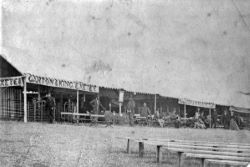 The very first image we have of a Company stand at a show is for the 1899 Bath & West Show where the company name is prominently shown and an enlargement shows metal field fencing and iron benches but, going by the left hand banner, only part of the total display area is visible.
The very first image we have of a Company stand at a show is for the 1899 Bath & West Show where the company name is prominently shown and an enlargement shows metal field fencing and iron benches but, going by the left hand banner, only part of the total display area is visible.
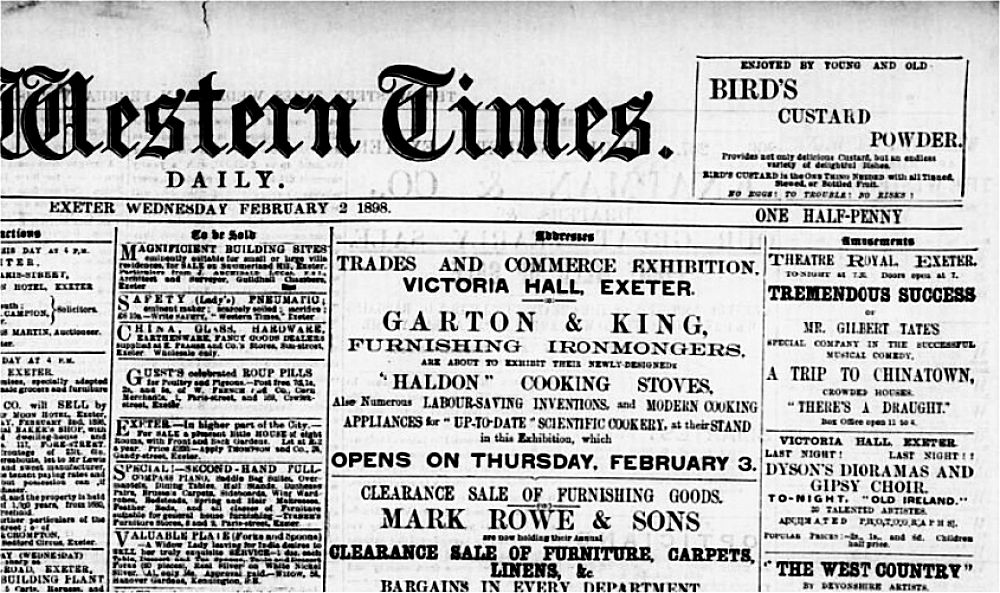 On February 3rd 1898 an event under the banner of ‘The Trades & Commerce Exhibition’ was staged at the Victoria Hall, Queen Street, Exeter and the Company took advantage of this opportunity to exhibit their Haldon Cooking Stoves as well as numerous labour-saving inventions.
On February 3rd 1898 an event under the banner of ‘The Trades & Commerce Exhibition’ was staged at the Victoria Hall, Queen Street, Exeter and the Company took advantage of this opportunity to exhibit their Haldon Cooking Stoves as well as numerous labour-saving inventions.
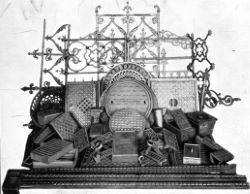 One other ‘Show’ which probably dates from the 1890s is this display of ironwork, fencing, railings, covers channels and inspection boxes. Quite where the photograph was taken is a mystery but it is likely that it was set up at a show somewhere as little appears in the background, unlike what you might expect to see in a shop display.
One other ‘Show’ which probably dates from the 1890s is this display of ironwork, fencing, railings, covers channels and inspection boxes. Quite where the photograph was taken is a mystery but it is likely that it was set up at a show somewhere as little appears in the background, unlike what you might expect to see in a shop display.
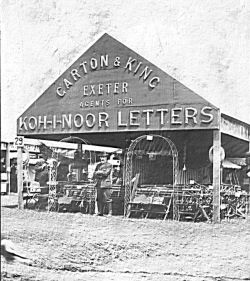 This next image relates to the company’s stand at the 1909 Bath & West Show at Exeter. Enlargement shows all manner of articles including seats and benches, frames for arbours and tables. The gentleman on duty seems unimpressed by the photographer, not a hint of a smile!
This next image relates to the company’s stand at the 1909 Bath & West Show at Exeter. Enlargement shows all manner of articles including seats and benches, frames for arbours and tables. The gentleman on duty seems unimpressed by the photographer, not a hint of a smile!
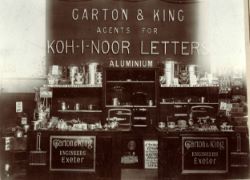 The Koh–I–Noor lettering features elsewhere in the company archives as shown in the next image, which is possibly from a showroom display. The lettering was a product of J Marston who became involved with Japanned goods and a variety of other products and then branched out and produced Sunbeam bicycles (later sold to BSA), Sunbeam Motor Cars and also Honeycomb Radiators. It is believed their successors still continue to trade.
The Koh–I–Noor lettering features elsewhere in the company archives as shown in the next image, which is possibly from a showroom display. The lettering was a product of J Marston who became involved with Japanned goods and a variety of other products and then branched out and produced Sunbeam bicycles (later sold to BSA), Sunbeam Motor Cars and also Honeycomb Radiators. It is believed their successors still continue to trade.
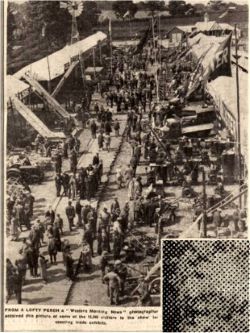 From 1890 onwards half tone images began to appear in newspapers; half tone converts the different tones in a photograph into dots of various sizes so creating shades of grey. However, this Western Morning News image of the 1936 Devon County Showground at Whipton, Exeter demonstrates the poorer quality of newspaper images compared with the photograph quality we are used to today – the ‘dot’ method (shown enlarged in the inset) has limited ability to reproduce detail in images of this type. Over 15,000 visitors attended this 1936 show.
From 1890 onwards half tone images began to appear in newspapers; half tone converts the different tones in a photograph into dots of various sizes so creating shades of grey. However, this Western Morning News image of the 1936 Devon County Showground at Whipton, Exeter demonstrates the poorer quality of newspaper images compared with the photograph quality we are used to today – the ‘dot’ method (shown enlarged in the inset) has limited ability to reproduce detail in images of this type. Over 15,000 visitors attended this 1936 show.
The 1952 Royal Show at Newton Abbot was the last show at which the company demonstrated their Foundry Products (see the Wheels & Gears page) – most post WW2 G & K displays at shows such as the Bath & West and the Devon County Show focussed mainly on the Domestic Appliance side of the business. The coming of the AGA in the early thirties lead to it soon becoming the main item on display at these and most future shows. There is coverage of this on the AGA – A Grand Affair web page.
Garton King Appliances usually have a stand at the Devon County Show but it has to be said that their name is not flaunted as in the past in spite of the reputation and heritage the combination of the names ‘Garton’ and ‘King’ together have gained over nearly 160 years, let alone the heritage that extends back to 1661. This image was taken at the 2013 Devon County Show.
If you have any images of the Garton & King’s Stand at past shows that you’d be happy to share then please see how to contact me on the About Me page.
Following the 1952 Royal Show the Foundry side of the business seemed to hold back on public advertising. An occasional article in a Trade Magazine such as The Ironmonger or Mechanical World might appear but this was to a somewhat select audience. An exception was the publicity surrounding the extremely large gears for Bamberton Cement in British Columbia (see the Wheels page). In 1953 images of the gears graced the pages of local newspapers such as the Express & Echo and Western Morning News.
 Unless you were an avid listener to the radio (or was it wireless?) in the late 1950s you may well have missed an audio snippet. This was possibly put out by the West of England Home Service which was founded in 1937 and was, as the documents below show, put together by Kenneth Hudson’s Talk Department of the BBC in Bristol in 1958. At that time BBC Radio was made up of Network 3, the Light Programme, the Home Service and the Third Programme.
If the written note on the transcripts is anything to go by it might well have been broadcast in late May or June 1958.
Unless you were an avid listener to the radio (or was it wireless?) in the late 1950s you may well have missed an audio snippet. This was possibly put out by the West of England Home Service which was founded in 1937 and was, as the documents below show, put together by Kenneth Hudson’s Talk Department of the BBC in Bristol in 1958. At that time BBC Radio was made up of Network 3, the Light Programme, the Home Service and the Third Programme.
If the written note on the transcripts is anything to go by it might well have been broadcast in late May or June 1958.
Kenneth Hudson OBE MA FSA 1916 – 1999 was a Journalist and prolific author; he moved to the BBC in Bristol in 1954 as a Radio Talks Producer and Industrial Correspondent, a post he held for 12 years. Much information about him is on Wikipedia.
The carbon copies headed “Round – Up” Insert To Devon for Iron Men show written alterations and amendments but by whom these were made is unknown, as is the reference to ‘Jones’ at the very beginning; the Compliment Slip has the written note “Copy sent to Mr (?) Judd 3 more attached”.
I can find no reference to this broadcast on the 4th June 1958 in the 30th May Issue of the Radio Times that covered that date, but it is my belief that this was indeed broadcast.
Some three years late and we are in the year (1961) of the Tercentenary of the Company. It was during this year that Henry Holladay took a different approach to the conventional means of gaining publicity. More in the vein of celebration as opposed to out and out publicity, he wrote on the 15th March to the Mayor’s Office at the Guildhall, Exeter. What he exactly wrote is not recorded, but the 29th March reply to the letter is shown here.
In response to this reply from the Mayor’s Secretary he presumably mulled over his options and came up with an alternative plan. This suggestion, whatever it was, is again not on record, but it did attract a direct reply (far right) from the Mayor, A.P. Steele-Perkins, and as far as I know no celebration of the kind described ever took place.
Updated June 2022
Top of page
See also:
144 Years of Adverts — Cooking Equipment
Wheels and Gears (Royal Show 1952) — Testimonials
King & Munk — Products
Sitemap / Contents